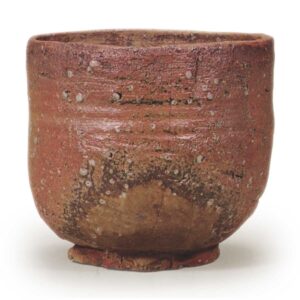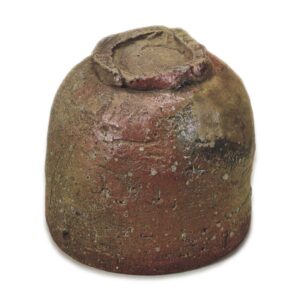

Collection: Nezu Museum
Height: 9.1cm
Diameter: 9.6-9.8cm
Base diameter: 5.5-6.0cm
Height: 0.8cm
Shigaraki has already been producing excellent tea ceremony ceramics such as vases and water jars since the Muromachi period, but there are surprisingly few tea bowls worth seeing. Among these, the Mizunoko is outstanding in terms of its appearance and has a long history, with a reputation that goes back to the Muromachi period. Matsudaira Fumai even recommended that it be treasured in the same way as the famous tea bowls of the Chuko period, and it has become the most famous tea bowl from Shigaraki.
The name “Mizunoko” is also said to be the name of the tea master Sōtan, but it is probably a reference to the white polka dots that appear on the surface of the tea bowl, which are formed when the feldspar grains in the clay melt.
As befits a tea bowl that was in the possession of Tsuda Sōyū, it is a work that retains an old-fashioned feel, but as the names of Shōō Shigaraki and Rikyū Shigaraki were already well known at the time, it is clear that this tea bowl was also made to suit the tastes of people like Sōyū, and that it was born as a tea bowl from the outset, with a simple beauty that exudes the subtle charm of tea.
It is a cylindrical tea bowl, and because it is Shigaraki ware, it is thick to begin with, but while the marks of the potter’s wheel are visible on the body, at first glance it has a hand-kneaded, roughly-hewn feel to it. Although Shigaraki ware does not use glaze, the texture of the skin is even more profound, and the subtle changes in color between the scarlet and yellowish-brown hues are further enhanced by the beauty of the scenery. Furthermore, the white glaze made from the melted feldspar grains contained in the clay is dotted all over the surface, and the way the white glaze reflects off the red skin, in irregular sizes and shapes, is particularly beautiful. This is the main highlight of the piece, and is probably the reason why it was given the name “Mizunoko”. The traces of the upper brushwork are somewhat visible, but this was done with the intention of smoothing out the surface of the vessel, and rather than being an artificial, decorative touch, as seen in later imitations, it actually adds to the natural appeal of the piece. The same is true of the foot ring, which is a false foot ring, but the way the cord has been twisted carelessly has resulted in a strangely attractive, distorted four-sided shape. There is also ash on the rim, which has become glazed and forms a scene.
There is a thin vertical crack running from the rim to the body.
Accessories
inner box paulownia wood, inscription on the underside of the lid Kakuzo Sai “Water Child, Shigaraki tea bowl, left (signature) Daitokuji Dainakuden”
In addition, the “Senke Chuko Meibutsu Ki” (Senke Family Revival Famous Tea Bowl Record) states that the box is inscribed with the words “Water Child” by Egetsu, so there may have been an old box with an inscription by Egetsu.
It was originally owned by Tsuda Soiku of Sakai, and then passed to his son, the priest Egetsu of Daitokuji, and then to the haiku poet Tanaka Sennai, and finally to the wealthy merchant Fuyuki Kiheiji of Fukagawa in Edo. However, in the Kansei era (1789-1801), it was sold to the tea master Matsudaira Fumai for 150 ryo. In modern times, it was passed down from the same family to Aoyama Nezu, and is now in the collection of the Nezu Museum.



